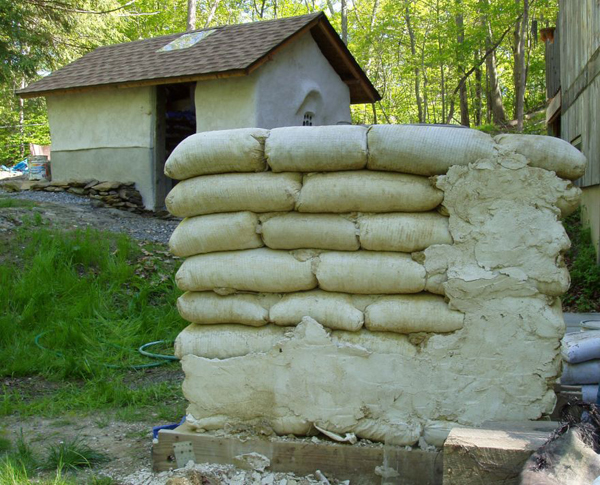
We appreciate stories from readers who document their projects and want to share what they’ve learned with others. Today’s blog post is from long time contributor Patti Stouter. She’s published some of the best free articles on the Internet. These articles (and everything else related to earthbag building) is archived at EarthbagBuilding.com.
“Lime plaster is more water-resistant than earthen plaster. Yet a relatively thin layer of this lime and sand protective coating can be applied on top of earthen plaster. Lime survives in humid, frosty places if the top of the wall is protected by a roof overhang.
The earthbag test wall in the foreground was plastered shortly after the earthbag shed shown in the background, during last fall. Both are in Holmes, NY which experiences frost but had mild weather during the past winter. They were both plastered with the same materials- first earthen plaster and then lime plaster on top. They were done by Patti Stouter, a relative novice at plastering.
The only difference is that the test wall had no roof overhang. It started out with a piece of tarp tied around the top, held down by some rocks. This blew partly off during the winter. I assume that rainfall soaked down between the lime plaster and the bags. It could have caused the earthen plaster to expand even without the added stress and expansion of freezing weather.
The lime plaster on the shed was in perfect condition. Lime is a very sturdy wall covering- if it is protected at the top.
I’d love to see details that work for using lime plaster in this type of climate on a site wall. The Japanese tile-roof topped walls are the only example that comes to mind. And they have a definite overhanging roof.”

hi,
I recently devised a lime plaster with which we have done a fresco in the uk, where temperatures can drop to -8C in winter.
I added a proportion of casein mixed in milk, in the following ratio:
2.5 litres lime putty, 4 litres marble powder (of various sizes from 45 micron to 1200 micron) and 125 ml of milk with 22 ml of casein added into the milk beforehand.
after this is mixed in, the plaster is a little stiff (because of the casein) so I added 100 ml of ordinary milk is added to loosen the mix.
so far it has lasted well – we even put the stuff on the wall in freezing temperatures and no cracking was experienced.
I cannot tell from the photo if the mix was correct but the application was definately wrong. This plaster was necer floated and if not floated will fail.
Google (Hempire Materials: Application of Hemp and Lime Plaster) to see how a lime plaster should be applied. See all 3 videos and note all 3 coats were floated.
http://www.youtube.com/watch?v=qrSpX8LF0Lw
It’s great to see how the earthbag shed turned out, since I laid a row or two on the bottom of it over a year ago.
God is good
jpu
Owen – Please read “Hydrated Lime” (not Dehydrated…). Since we make “Dehydrated Pineapple fruits” here I got mixed up on this. Sorry if this causes confusion.
I will try to send you some pics per separate post.
Thanks for the input, and the recipe for lime plaster.
Note the error (now corrected): it should say hydrated lime not dehydrated lime.
The best experience we found for outdoor Plasters is using 90%-91% Dehydrated Lime. We fill this hydrated Lime in blue drums (55gal. drums) and add water to a ratio of about 1 kg (2.2 pounds) to 1 gal. of water. We re-stir this Lime/Water mix every day during the next 4-5 days.
After that we only check to ensure the mix is always soaked in water (the top Lime layer should not be exposed to air. it should always remain a few inches under water).
When we Plaster we take this Lime soaked in water and mix with sand and add water as may be needed.
The mix that best worked for us for Outdoor Wall Plaster is a ratio 3x sand to 1x Lime.
In our tropical region with high humidity this mixture will take forever to dry. To expedite the drying time we add some cement to this mix, normally in the region of 20% of the weight of the Lime (or 5% of the entire Sand/Lime weight).
In dryer climates this should not be necessary as the Lime Plaster should dry fine in a timely manner (not to get washed off by rain before drying).
Our “Majestic El Chorrera Dome” was covered with the above Lime Plaster mix 2 years ago after suffering various other Wall Plaster Mixes (all failed). The Dome is now withstanding its 3rd rainy season and till date we have not seen any problems and we have not even applied the last and finishing layer yet…
Excellent advice, thanks. This sounds good enough for a blog post. Do you have a close-up view of the plaster? 600 pixel wide photograph is best. (I can shrink larger photos.)